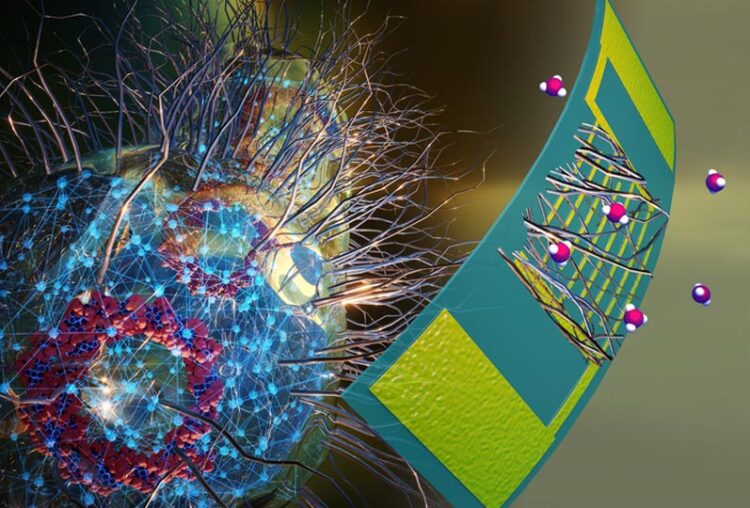“Electronic nose” built with sustainably sourced microbial nanowires

Specific molecules stick to the nanowires grown on genetically modified E. coli.
Credit: UMass Amherst
… that could revolutionize health monitoring.
Breakthrough in green technology represents a new, biological paradigm in electrical engineering.
Scientists at the University of Massachusetts Amherst recently announced the invention of a nanowire, 10,000 times thinner than a human hair, which can be cheaply grown by common bacteria and can be tuned to “smell” a vast array of chemical tracers—including those given off by people afflicted with different medical conditions, such as asthma and kidney disease. Thousands of these specially tuned wires, each sniffing out a different chemical, can be layered onto tiny, wearable sensors, allowing health-care providers an unprecedented tool for monitoring potential health complications. Since these wires are grown by bacteria, they are organic, biodegradable and far greener than any inorganic nanowire.
To make these breakthroughs, which were detailed in the journal Biosensors and Bioelectrics, senior authors Derek Lovley, Distinguished Professor of Microbiology at UMass Amherst, and Jun Yao, professor of electrical and computer engineering in the College of Engineering at UMass Amherst, needed to look no farther than their own noses. “Human noses have hundreds of receptors, each sensitive to one specific molecule,” says Yao. “They are vastly more sensitive and efficient than any mechanical or chemical device that could be engineered. We wondered how we could leverage the biological design itself rather than rely on a synthetic material.”
In other words, the team wondered if they could work with nature to sniff out disease—and it turns out they have done just that.
The answer begins with a bacterium known as Geobacter sulfurreducens, which Lovley and Yao previously used to create a biofilm capable of producing long-term, continuous electricity from your sweat. G. sulfurreducens’ has the surprising natural ability to grow tiny, electrically conductive nanowires.
But G. sulfurreducens is a finicky bacterium that needs specific conditions in which to grow, making it difficult to use at scale. “What we’ve done,” says Lovley, “is to take the ‘nanowire gene’—called pilin—out of G. sulfurreducens and splice it into the DNA of Escherichia coli, one of the most widespread bacteria in the world.”
Once the pilin gene was removed from G. sulfurreducens, Lovley, Yao and team modified it so that it would include a specific peptide, known as DLESFL, which is extremely sensitive to ammonia—a chemical often present in the breath of those with kidney disease. When they then spliced the modified pilin gene into E. coli’s DNA, the genetically tweaked bacterium sprouted tiny nanowires bristling with the ammonia-sensing peptide. The team then harvested these ammonia-sensitive nanowires and built them into a sensor.
“Genetically modifying the nanowires made them 100 times more responsive to ammonia than they were originally,” says Yassir Lekbach, the paper’s co-lead author and a postdoctoral researcher in microbiology at UMass Amherst. “The microbe-produced nanowires function much better as sensors than previously described sensors fabricated with traditional silicon or metal nanowires.”
And there’s no need to limit these new sensors to only to ammonia and kidney disease. Toshiyuki Ueki, the paper’s other co-lead author and research professor in microbiology at UMass Amherst, says that “it’s possible to design unique peptides, each of which specifically binds a molecule of interest. So, as more tracer molecules, emitted by the body and which are specific to particular a disease are identified, we can make sensors that incorporate hundreds of different chemical-sniffing nanowires to monitor all sorts of health conditions.”
A new paradigm for electrical engineering
Traditional nanowires, made from silicon or carbon fiber, can be highly toxic—carbon nanotubes are themselves carcinogens—and end up as non-biodegradable e-waste. Their raw materials can require enormous amounts of energy and chemical inputs to harvest and process, as well as leaving a deep environmental impact. But because Lovley and Yao’s nanowires are grown from common bacteria, they are far more sustainable.
“One of the most exciting things about this line of research,” says Yao, “is that we’re taking electrical engineering in a fundamentally new direction. Instead of wires made from scarce raw resources that won’t biodegrade, the beauty of these protein nanowires is that you can use life’s genetic design to build a stable, versatile, low impact and cost-effective platform.”
This research was supported by the National Science Foundation and nurtured by the Institute for Applied Life Sciences (IALS) at UMass Amherst, which combines deep and interdisciplinary expertise from 29 departments to translate fundamental research into innovations that benefit human health and well-being.
Contacts:
Derek Lovley, dlovley@umass.edu
Daegan Miller, drmiller@umass.edu
Journal: Biosensors and Bioelectronics
DOI: 10.1016/j.bios.2023.115147
Article Title: Microbial nanowires with genetically modified peptide ligands to sustainably fabricate electronic sensing devices
Article Publication Date: 10-Feb-2023
Media Contact
Daegan Miller
University of Massachusetts Amherst
drmiller@umass.edu
All latest news from the category: Medical Engineering
The development of medical equipment, products and technical procedures is characterized by high research and development costs in a variety of fields related to the study of human medicine.
innovations-report provides informative and stimulating reports and articles on topics ranging from imaging processes, cell and tissue techniques, optical techniques, implants, orthopedic aids, clinical and medical office equipment, dialysis systems and x-ray/radiation monitoring devices to endoscopy, ultrasound, surgical techniques, and dental materials.
Newest articles

Innovative 3D printed scaffolds offer new hope for bone healing
Researchers at the Institute for Bioengineering of Catalonia have developed novel 3D printed PLA-CaP scaffolds that promote blood vessel formation, ensuring better healing and regeneration of bone tissue. Bone is…

The surprising role of gut infection in Alzheimer’s disease
ASU- and Banner Alzheimer’s Institute-led study implicates link between a common virus and the disease, which travels from the gut to the brain and may be a target for antiviral…

Molecular gardening: New enzymes discovered for protein modification pruning
How deubiquitinases USP53 and USP54 cleave long polyubiquitin chains and how the former is linked to liver disease in children. Deubiquitinases (DUBs) are enzymes used by cells to trim protein…



